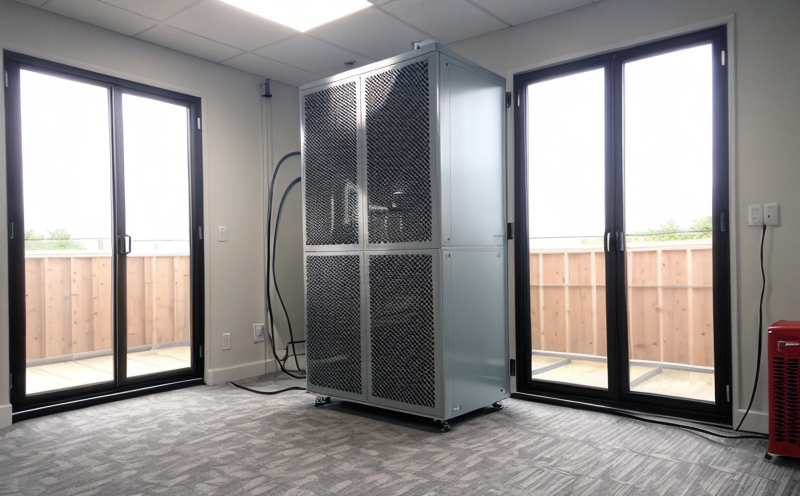ISO 14644-3 Particle Concentration and Airflow Assessment
The ISO 14644 series of standards is widely recognized in industries that require clean environments, such as pharmaceuticals, electronics manufacturing, and biotechnology. Within this framework, ISO 14644-3 specifically addresses the determination of particle concentrations and airflow in cleanrooms. This service ensures compliance with international benchmarks for air quality, which is crucial to maintaining product integrity and safety.
Airflow and particle concentration are two critical parameters that influence the overall cleanliness level of a space. Poor control over these factors can lead to contamination issues, affecting both the manufacturing process and final products. Our ISO 14644-3 service provides comprehensive testing to ensure these parameters meet or exceed specified standards.
Our testing methodology involves several key steps: first, we establish baseline conditions within the space using advanced instrumentation such as particle counters, flow meters, and laser diffraction systems. These tools allow for precise measurement of both particle size distribution and airflow rates across different sections of the cleanroom.
The data collected during this process is then analyzed according to ISO 14644-3 guidelines to determine whether the space adheres to required classifications (Class 1 through Class 9). Compliance with these classifications ensures that all operations within the cleanroom are conducted under controlled and safe conditions. For instance, in pharmaceutical manufacturing, maintaining a certain level of particle concentration is essential for preventing contamination which could compromise drug efficacy or even patient safety.
Our team of experts can help you understand how this service fits into your overall quality management system (QMS). By integrating ISO 14644-3 testing into regular maintenance schedules, companies in sectors like healthcare and electronics can ensure consistent product quality while also meeting regulatory requirements. This proactive approach not only enhances operational efficiency but also protects brand reputation.
For those looking to innovate within their respective industries—whether through new product development or process optimization—the ability to accurately measure particle concentrations and airflow provides valuable insights into potential improvements. Real-world applications include identifying sources of contamination, optimizing HVAC systems for better energy efficiency, and ensuring worker safety by minimizing exposure risks.
Why It Matters
The importance of accurate measurement cannot be overstated when it comes to maintaining cleanroom environments compliant with ISO 14644-3. Cleanrooms are used extensively across various sectors including pharmaceuticals, electronics manufacturing, and biotechnology where even small amounts of particulate matter can have significant impacts on product quality.
- Pharmaceutical Manufacturing: Ensuring that drugs produced in clean environments do not contain harmful contaminants is paramount. Any breach could result in ineffective medicines or even pose health risks to consumers.
- Biotechnology: Similar considerations apply here, where genetic research and biomanufacturing processes need to be conducted under sterile conditions free from external pollutants.
- Electronics Manufacturing: In industries like semiconductors, even the smallest dust particles can cause short circuits or other malfunctions that could cost millions in lost production time and revenue.
In addition to these direct benefits for manufacturers, ensuring compliance with ISO 14644-3 also contributes positively towards public health. For example, hospitals often rely on clean air filtration systems to prevent the spread of infectious diseases among patients and staff members.
By offering this service, we contribute to maintaining high standards across multiple critical areas impacting both industry performance and public wellbeing.
Industry Applications
The application of ISO 14644-3 particle concentration and airflow assessment extends beyond just pharmaceuticals and electronics; it plays a vital role in many other sectors as well. Here are some industries where this service is particularly valuable:
- Pharmaceutical Manufacturing: Ensuring that drugs produced in clean environments do not contain harmful contaminants is paramount.
- Biotechnology Research: Genetic research and biomanufacturing processes need to be conducted under sterile conditions free from external pollutants.
- Hospital Cleanrooms: Maintaining a certain level of particle concentration within hospital cleanrooms helps prevent the spread of infectious diseases among patients and staff members.
- Electronics Manufacturing: In industries like semiconductors, even the smallest dust particles can cause short circuits or other malfunctions that could cost millions in lost production time and revenue.
- Aerospace Engineering: Clean environments are crucial for testing components and materials used in spacecraft and aircraft where even minor contamination can have severe consequences.
- Microelectronics: The semiconductor industry relies heavily on cleanroom technology to produce high-performance chips free from defects caused by particulate matter.
In all these fields, the ability to accurately measure particle concentrations and airflow ensures consistent product quality while also meeting stringent regulatory requirements. This not only enhances operational efficiency but also protects brand reputation.
Competitive Advantage and Market Impact
- Enhanced Quality Control: By adhering to ISO 14644-3 standards, organizations can demonstrate their commitment to quality assurance. This builds trust with customers who value reliability.
- Regulatory Compliance: Ensuring compliance helps avoid costly fines and legal action that non-compliance might entail.
- Innovation Opportunities: Understanding the precise conditions within cleanrooms allows companies to explore innovative solutions for improving processes or developing new products.
- Worker Safety: Minimizing exposure risks through accurate monitoring ensures a safer working environment for personnel involved in sensitive operations.
The ability to consistently meet these standards sets your organization apart from competitors, fostering long-term relationships and contributing to sustainable growth. In an increasingly competitive global market, demonstrating leadership in cleanliness and safety can significantly enhance brand value and customer loyalty.





